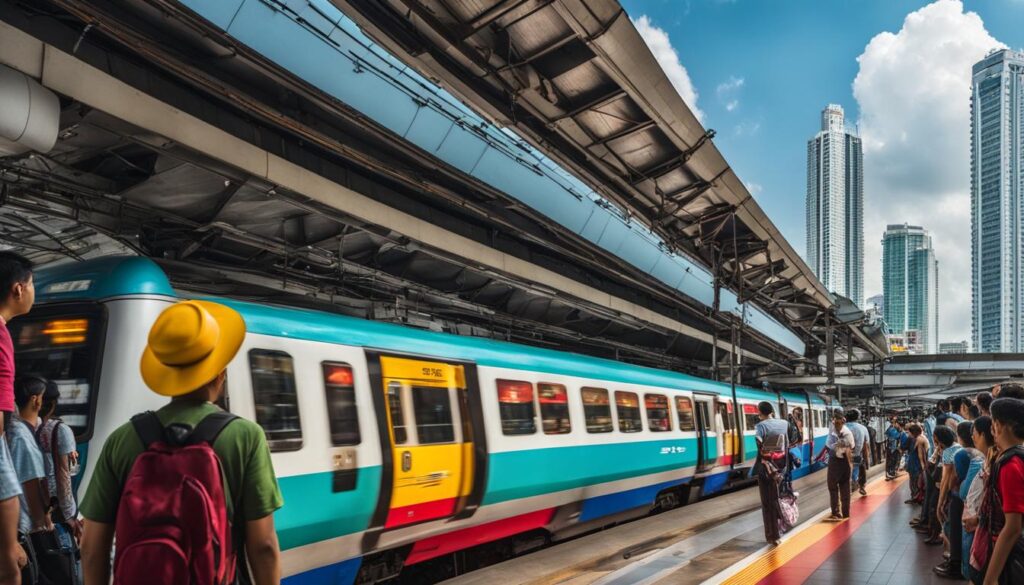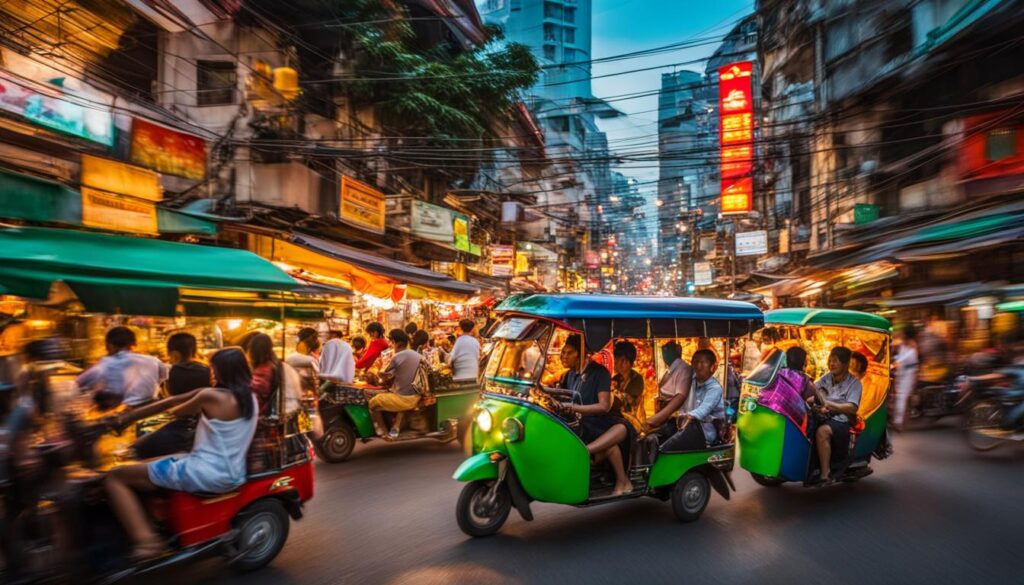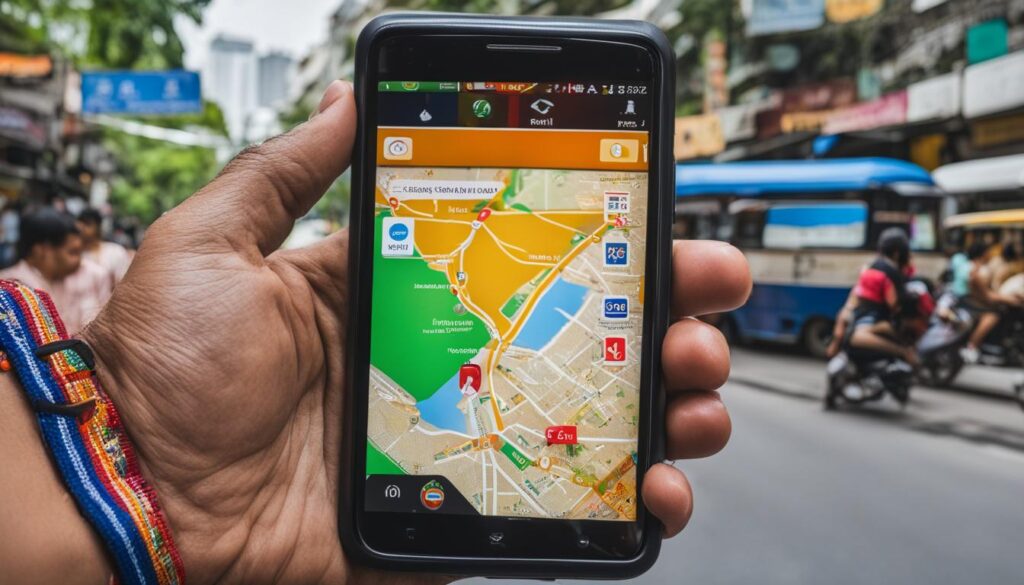Are you planning a trip to Bangkok but worried about navigating the city without speaking Thai? Don’t let the language barrier hold you back from exploring this vibrant and exciting destination. In this comprehensive travel guide, you will learn helpful tips and strategies to get around Bangkok even if you don’t speak Thai.
Bangkok has a well-connected transportation system that includes a network of trains, buses, taxis, tuk-tuks, and river ferries. With a little preparation and know-how, you can easily navigate the city without relying on the local language.
In this guide, you will discover the different transportation options available, including the most convenient and efficient ways to travel within Bangkok, such as the Skytrain (BTS) and Metro (MRT) systems. You will also learn how to communicate with taxi drivers, negotiate fares, and use ride-hailing apps. If you prefer a more personalized experience, you’ll find information on hiring private drivers and guides.
But getting around Bangkok is not just about transportation. You’ll also learn about useful language apps, offline maps, and travel-specific apps that can help you overcome language barriers. And to enhance your experience even further, we’ll cover essential phrases and cultural norms to navigate daily interactions and show respect to the locals.
By the end of this guide, you will have all the knowledge and resources you need to confidently explore Bangkok and create lasting memories, all without speaking Thai. So let’s get started on your journey to mastering Bangkok.
Understanding Bangkok’s Transportation System
As a non-Thai speaker, navigating Bangkok’s transportation system can seem daunting. However, with a little research and preparation, you can easily get around the city using public transport.
Bangkok’s transportation system is well-connected and offers various options, including trains, buses, taxis, and tuk-tuks.
Trains
Bangkok has two train systems: the Skytrain (BTS) and the Metro (MRT). These are the most convenient and efficient ways to travel around the city.
The trains are equipped with English signage and announcements, making it easy to understand the routes and stations. You can purchase tickets at the stations using English instructions on the ticket machines or through the Rabbit card system.
The Rabbit card is a refillable card that you can use to pay for your train rides and can be purchased at the stations. You can top up the card as needed and can use it for both the Skytrain and the Metro.
Buses
Buses in Bangkok are a cheaper alternative to the trains and offer an extensive network of routes. They are also equipped with English signage, and some have announcements in English. You can use Google Maps or the Moovit app to plan your route and look up the bus numbers and schedules.
Taxis
Taxis are a popular mode of transport in Bangkok. While most taxi drivers do not speak English, you can communicate with them by showing them your destination address written in Thai or using popular ride-hailing apps like Grab or Uber, where you can input your destination in English. You can also download the “Grab” application to order motorcycle taxis.
Tuk-tuks
Tuk-tuks are a quintessential mode of transportation in Bangkok and offer a unique and adventurous way to travel around the city. To negotiate fares with the tuk-tuk drivers, use basic English or use a translation app. Make sure to agree on the price before starting your journey.
River Ferries
The Chao Phraya River offers a scenic and leisurely way to travel around Bangkok. There are different types of river ferries, including the express boat, tourist boat, and local boat. Look for signage and ask staff for help. You can use the Rabbit card and Google Maps to navigate the river ferries.
English language apps and maps
There are various apps that can help you navigate Bangkok’s transportation system, including Google Maps, Moovit, and Grab. These apps provide information on routes, schedules, and fares. Additionally, language translation apps and offline maps can help you overcome language barriers and understand your surroundings.
By understanding the various transportation options and utilizing technology, you can confidently navigate Bangkok’s transportation system without relying on Thai language skills.
Understanding Bangkok’s Transportation System
Getting around Bangkok without speaking Thai may seem daunting, but with a little research and preparation, you can travel efficiently through the city without relying on language skills. Before exploring the various transportation options available, it’s essential to familiarize yourself with Bangkok’s transportation system.
Bangkok’s transportation system includes a well-connected network of trains, buses, taxis, and tuk-tuks. The Skytrain (BTS) and Metro (MRT) systems are the most convenient and efficient ways to travel within Bangkok.
The Skytrain operates two lines: the Sukhumvit Line and the Silom Line, while the Metro has a single line running from Hua Lumphong Station to Bang Sue Station. The two systems connect at several interchange stations, making it easy to switch between them.
Public buses are another popular mode of transportation in Bangkok, but they can be challenging to navigate if you don’t speak Thai. To overcome language barriers, look for buses with English signage or take advantage of mobile apps that provide information on bus routes and schedules.
Taxis are widely available in Bangkok, but communication with drivers can be difficult if you don’t speak Thai. To overcome this, carry a map of your destination and show it to the driver, or use popular ride-hailing apps like Grab or Uber, where you can input your destination in English.
Tuk-tuks are a fun and unique way to explore Bangkok’s bustling streets, but be prepared to negotiate fares. English may not be widely spoken by tuk-tuk drivers, so it’s helpful to learn a few basic phrases like “How much?” and “Go to _____.”
Finally, renting a bicycle or motorbike is a convenient way to explore Bangkok at your own pace. However, keep in mind that traffic in Bangkok can be chaotic, so it’s essential to follow traffic rules and wear protective gear when necessary.
With so many transportation options available, it’s easy to get around Bangkok without speaking Thai. Utilize English signage, translation apps, and mobile maps to navigate the city efficiently. Whether you prefer the convenience of the Skytrain or the adventure of a tuk-tuk ride, you can make the most of your visit to Bangkok.
Using Taxis and Ride-Hailing Apps
As a non-Thai speaker, using taxis can be a convenient way to get around Bangkok. However, it’s essential to know how to communicate with taxi drivers without speaking Thai.
One way to avoid language barriers is to use popular ride-hailing apps like Grab or Uber. These apps allow you to input your destination in English, and the app will automatically find a driver for you.
If you choose to take a taxi, it’s important to show the driver your destination address in Thai or have a map with the location marked. You can easily find Thai translations of popular tourist destinations online or ask your hotel staff for assistance.
Taxi drivers in Bangkok are required to use the meter, but some may try to negotiate a fixed price. If a driver refuses to use the meter, it’s best to find another taxi. Be aware that traffic in Bangkok can be heavy, so be sure to allow plenty of time for travel.
Exploring Bangkok by Tuk-Tuk
If you’re looking for a unique and adventurous way to explore Bangkok without speaking Thai, then tuk-tuks are an excellent choice. Tuk-tuks are three-wheeled motorized vehicles that are a common sight on the streets of Bangkok. They’re smaller and more nimble than taxis, making them perfect for navigating the city’s bustling streets and alleys.
When riding a tuk-tuk, be sure to negotiate the fare with your driver before getting in. Many drivers will try to overcharge tourists, so it’s important to agree on a price beforehand to avoid any confusion or disputes.
Communicating with tuk-tuk drivers can be a challenge since many of them do not speak English fluently. However, you can use basic English phrases to convey your destination and negotiate the fare. For example, you can say “Wat Phra Kaew” (the Temple of the Emerald Buddha) or “Khao San Road” (a popular backpacker area) to indicate where you want to go. You can also use hand gestures and maps to communicate effectively.
It’s important to note that tuk-tuks are not the most comfortable mode of transportation, especially in hot and humid weather. They’re also not the safest, so be sure to wear a helmet if one is provided and hold on tight!
If you’re up for an adventure and want to explore Bangkok like a local, then taking a tuk-tuk ride is a must-do experience. Just remember to negotiate the fare and communicate clearly with your driver to ensure a safe and enjoyable ride.
Embracing the Chao Phraya River Ferries
One of the best ways to sightsee in Bangkok without speaking the local language is by taking a ferry along the Chao Phraya River. The river is a major transportation artery in Bangkok and connects various tourist destinations, making it an efficient and scenic way to travel.
The Chao Phraya River Express Boat is a popular choice for tourists, with several lines to choose from that stop at various piers along the river. The boat’s orange flag denotes that it is an “express” service that stops at major piers, while the blue flag denotes a local boat that stops at every pier along the route.
To navigate the river, refer to the route map and the announcement board on the boat that displays the approaching pier. Announcements are made in both Thai and English, so listen out for your destination.
Some of the popular attractions that can be reached via the Chao Phraya River include the Grand Palace, Wat Arun, Chinatown, and the Asiatique Night Market. The river also provides a great vantage point to admire the city skyline and observe the local way of life along the riverbank.
Keep in mind that the river can get crowded during peak hours, so plan your trip accordingly. Also, be prepared for occasional delays due to heavy traffic or other factors.
When boarding the boat, pay the fare to the conductor, who will approach you for payment. For a more comfortable experience, opt for the air-conditioned boats, which are slightly more expensive than the non-air-conditioned ones.
Overall, taking a ferry along the Chao Phraya River can be a memorable experience that offers a unique perspective of Bangkok. It’s a great way to see the city’s landmarks and attractions without worrying about getting lost or navigating the language barrier.
Using Taxis and Ride-Hailing Apps
Taxis are a popular mode of transportation, especially for getting around Bangkok. As a non-Thai speaker, it can be intimidating to communicate with taxi drivers, but with the help of technology and a few tips, you can easily get to your destination.
To start, it’s helpful to have your destination address written in Thai characters to show the driver. You can ask your hotel concierge or use a translation app to write it down. Alternatively, many ride-hailing apps like Grab and Uber allow you to input your destination in English and will automatically translate it for the driver.
It’s also a good idea to have a rough idea of how much the ride should cost. You can use websites or apps such as taxi fare calculators or compare prices from multiple ride-hailing apps.
When you hail a taxi on the street, look for taxis with red and white or yellow and green colors. These are usually metered taxis. Before getting in, make sure the taxi driver turns on the meter. If the driver refuses to use the meter, find another taxi.
If you’re using a ride-hailing app, make sure to confirm the license plate number and driver’s details before getting in the car. It’s also helpful to share your location with a friend or family member so they can track your ride.
Overall, using taxis or ride-hailing apps can be a convenient and efficient way to get around Bangkok, even if you don’t speak Thai. With a little preparation and caution, you can confidently explore the city at your own pace.
Hiring Private Drivers and Guides
For a more personalized and hassle-free experience in Bangkok, hiring a private driver or guide may be the perfect option for you. With a private driver, you can avoid the hassle of navigating public transportation and enjoy the luxury of being transported directly to your destination.
Private guides can be particularly helpful if you’re interested in learning more about Bangkok’s history, culture, and hidden gems. A knowledgeable guide can offer insights and recommendations that you may not find in guidebooks or online resources.
When hiring a private driver or guide, be sure to communicate your needs and preferences clearly. Choose drivers or guides who are English-speaking and have good reviews from previous clients. You can find private drivers and guides online through various travel agencies or on websites like TripAdvisor.
Private Driver vs. Ride-Hailing Apps
If you’re debating between hiring a private driver or using ride-hailing apps like Grab or Uber, there are a few things to consider. While ride-hailing apps can be convenient and affordable, they don’t offer the same level of personalized service as a private driver. Additionally, drivers through ride-hailing apps may not be as familiar with the city as a local private driver.
On the other hand, ride-hailing apps can be useful for shorter trips or when you don’t have a specific itinerary in mind. They also eliminate the need for communication with a driver, as you can input your destination in English through the app.
| Private Driver | Ride-Hailing Apps |
|---|---|
| Personalized service | Convenient and affordable |
| English-speaking | No need for communication with driver |
| Local knowledge | Useful for shorter trips or spontaneous outings |
Ultimately, the decision between hiring a private driver or using ride-hailing apps depends on your personal preferences and needs.
Utilizing English Language Apps and Maps
Overcoming language barriers in Bangkok can be a challenge for non-Thai speakers, but technology has made it easier to navigate the city. There are several English language apps and maps that can assist you in getting around and communicating with locals. Here are some popular apps you can download to your smartphone:
- Google Translate: This app can translate words and phrases into Thai and even allows for two-way conversation translation.
- Grab: A ride-hailing app that allows you to input your destination and communicate with your driver in English.
- Currency Converter: Convert Thai baht to your home currency quickly and easily.
- TripAdvisor: Find reviews, recommendations, and directions to popular attractions and restaurants in Bangkok.
- Maps.me: An offline map app that allows you to navigate Bangkok’s streets without using data or Wi-Fi.
In addition to these apps, it’s essential to have a paper map of the city as a backup. Most hotels provide free maps, or you can pick one up at a tourist information center. Having a map on hand will help you navigate the city streets and communicate your destination to taxi and tuk-tuk drivers.
“Don’t let language barriers hinder your Bangkok experience. Make use of technology and be prepared with a map to get around with ease.”
Useful Phrases and Local Etiquette
While navigating Bangkok without speaking Thai may seem daunting, learning a few essential phrases and understanding local etiquette can greatly enhance your experience and make interactions smoother. Here are some helpful tips:
Useful Phrases
- Sawadee krap (if you’re male)/ka (if you’re female): Hello/Goodbye
- Khop khun krap (if you’re male)/ka (if you’re female): Thank you
- Kor tot (insert destination) pai mai krap/ka?: Do you go to (insert destination)?
- Nit noy krap/ka: A little bit please
- Mai pen rai krap/ka: No problem/You’re welcome
Local Etiquette
Thai people are generally warm and welcoming, and showing respect for their culture and customs can go a long way:
- Wai: The Thai gesture of greeting involves pressing your palms together in front of your chest and bowing slightly. This is a sign of respect and is often reciprocated by locals.
- Remove your shoes: Before entering temples, homes, or certain businesses, it is customary to remove your shoes.
- Cover up: Dress modestly when visiting temples or other religious sites. Avoid wearing revealing clothing such as shorts, tank tops, or low-cut tops.
- Don’t touch people’s heads: In Thai culture, the head is considered sacred and should not be touched. Similarly, pointing your feet at someone or something is considered rude.
- Smile: Thais are known for their friendly smiles, and a simple smile can go a long way in establishing a positive connection.
By learning a few basic phrases and adhering to local customs, you can navigate Bangkok with ease and show respect for the local culture.
Conclusion
Navigating Bangkok without speaking Thai may seem daunting at first, but with the right knowledge and resources, you can confidently explore the vibrant city. Remember to familiarize yourself with the different transportation options, utilize technology, and be open to cultural differences.
Whether you choose to ride the Skytrain, hail a taxi, explore on a tuk-tuk, or embrace the Chao Phraya River ferries, there are plenty of ways to get around Bangkok as a non-Thai speaker. Renting bicycles or motorbikes and hiring private drivers or guides are also great options to consider.
Make use of language translation apps, offline maps, and travel-specific apps to overcome language barriers. Learning a few essential phrases and understanding local etiquette can also go a long way in enhancing your experience in Bangkok.
By following the tips and strategies outlined in this comprehensive travel guide, you can confidently navigate Bangkok without speaking Thai and create lasting memories in this extraordinary city.
















































